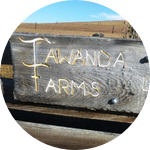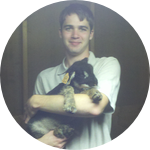Project Results
Brown coat color, the B Locus, in sheep is known to be recessive to black; however, the potential molecular cause(s) across various breeds have not yet been discovered. Based on evidence from other species, TYRP1 is hypothesized to carry mutations responsible for changes from black to brown pigment in sheep breeds raised for wool. In the present study, we investigated the TYRP1 gene by Sanger sequencing the coding regions across several sheep populations within the United States that contain black and brown individuals. We identified two SNPs associated with brown coat color (chr2:80,608,128G>T and chr2:80,611,700C>T) located within exon 3 and 4, respectively. The exon 3 SNP leads to an amino acid change from cysteine to phenylalanine (C290F) and the exon 4 SNP introduces a premature stop codon in the TYRP1 protein (R356X). These SNPs segregate by breed where R356X is found in Icelandics and Shetlands, C290F is found in Natural Colored Finewool and Finnsheep, and Romeldales and Romneys carry both mutations. The results from this study provide more insight into coat color genetics in sheep and will allow breeders to make more accurate breeding decisions to meet their wool markets.
About This Project
Sheep come in a variety of different patterns and colors, with black or white individuals being the most common. Brown is another rarer option, often called Moorit. There are no genetic tests currently available for shepherds to identify moorit carriers. Our project aims to identify the genetic variants responsible for moorit in sheep using a candidate gene sequencing approach. Discovering the genetic basis for moorit will allow shepherds to make more informed breeding decisions in their flocks.
Ask the Scientists
Join The DiscussionWhat is the context of this research?
Moorit sheep are present in several domesticated sheep breeds such as the Romeldale, Merino, Finnsheep, and many others. While it is known that this is a recessive trait there has been no work to determine the molecular cause of this color in domesticated sheep breeds. Work done in mice, dogs, and Chinese pigs has shown changes within the Tyrosinase-related Protein (TYRP1) gene that result in brown color. A small study conducted in a wild sheep population discovered a mutation in TYRP1 that was associated with a light brown coat color. However, this mutation has not yet been studied in US sheep breeds raised specifically for wool production.
What is the significance of this project?
Shepherds have been selecting for various color and patterns in sheep for hundreds of years as evidenced by breed development. Most research to date on sheep color has focused on the Agouti gene, which determines the different patterns that are seen in various sheep breeds. TYRP1 is the most likely genetic cause of brown coat color based on evidence from mice and dogs. This project will be the first to sequence TYRP1 in sheep breeds bred specifically for wool production in the US. It is important to learn if the same mutation is responsible for brown across different sheep breeds indicating an early origin of brown color or if the breeds have developed brown color independently of each other. This project will provide more insight into our understanding of sheep coat color genetics.
What are the goals of the project?
The goal of this project is to sequence 30 unrelated individuals, approximately 15 black and 15 moorit, for the candidate gene, TYRP1, thought to control brown coat color. We want to determine the specific mutations in the DNA that are responsible for brown coat color. We hope to determine if the same mutation causing moorit is shared among breeds or if there are different mutations resulting in the same color. This project will provide sequencing data that we can use to determine a cost-effective genotyping technique that shepherds can use to make more informed breeding decisions.
Budget
The travel support is for travel to several farms for blood sample collection and characterization of unrelated sheep enrolled in the project. The DNA collection and extraction costs will cover the supplies and reagents needed to collect blood and extract DNA. DNA primers will be designed and purchased to amplify the entire coding region of TYRP1. These regions will be sequenced at the Cornell University Biotechnology Resource Center on an ABI 3703x1 DNA analyzer. This will read the individual bases that we can use to compare sequences of individuals of different coat colors. The restriction enzymes will be used to develop a cost-efficient test that breeders could use for their sheep. We already have the appropriate software that will allow us to analyze the sequences and identify possible mutations.
Endorsed by
Meet the Team
Team Bio
Visit our website: http://blogs.cornell.edu/odysseydnalab/ to learn more about the livestock genetics and genomics research we do at Cornell University
Christian Posbergh
I am currently a graduate student in the Department of Animal Science at Cornell University. I completed my undergraduate degree in Animal Science in May 2015 at Cornell University. My research is focused on the genetics of economically important traits in the US Sheep industry such as out of season lambing, mature body size, and growth. Other projects I am working on include investigating the genetics of Guernsey cattle and musk ox. As an undergraduate researcher I have worked on several projects in sheep, cattle, and horses that involved gene sequencing and variant identification for various traits.
I have raised sheep for several years, specifically Romneys and Dorsets. I am currently president of the American Romney Breeders Association. Ever since discovering the possibilities for sheep color and patterns I have been fascinated with the genetics of sheep color.
Heather Huson
I am an Assistant Professor of animal genetics in the Department of Animal Science at Cornell University. I use modern genomic technology to study population dynamics of animals including inbreeding and ancestry. I also conduct association studies to identify genetic markers related to health, performance, and conformational traits. My students and I conduct research on livestock including dairy cattle, sheep, and goats, as well as projects in working dogs and wildlife. My primary objective is to use genomic technology to assist farmers and breeders in the improvement of animal health and performance through selective breeding and management.
Project Backers
- 70Backers
- 111%Funded
- $5,551Total Donations
- $79.30Average Donation




